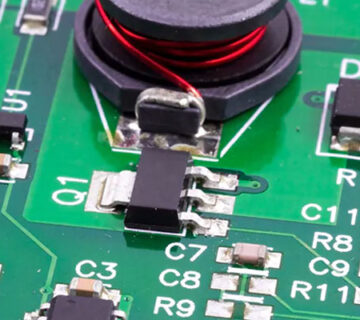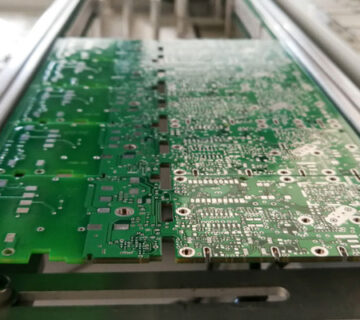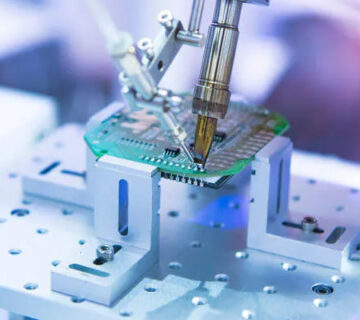With large numbers of PCBs being manufactured every day, manufacturers are opting for automated processes with innumerous machines being used to fulfill all the procedures. Machines not only make the task easier for the manufacturers, but faster and accurate too. Now, if you are inquisitive about what kinds of machineries are used, and how, then this blog is the perfect place for you. Here, we will let you know about all the machineries used at each stage of the PCB manufacturing process – paste application, component placement, soldering, and inspection/testing.
Paste application
The first step for manufacturing a PCB assembly from India is to apply the solder paste onto the board, which is a grey coloured paste made from a mixture of tiny particles of metal alloys like tin, lead, and silver, used as a glue to hold all the components of the board together.
Solder paste printing machine – This is a very useful machine that helps apply this paste evenly on the PCB board. But, before applying the paste, a stainless steel sheet having small laser-cut holes is placed on the board to allow solder paste to be applied only on the areas of the board where the components need to be placed. The board and the stainless steel stencil are locked into place in the solder paste printing machine, which has a squeegee that applies the solder paste on the board in exact amounts. A blade attached to the machine then drags across the stencil to spread the paste evenly over the entire sheet. The stencil is then removed to have the solder paste in the areas where it is required for the components to stick on.
Solder paste inspection machine – The next step involves checking if the solder paste has been properly printed onto the board. While the solder paste printing machine is likely to spread the paste evenly and accurately on the sheet, it is always better to have an inspection before moving ahead, to avoid expensive rework costs later. The inspection machine uses cameras that can capture 3D images to weigh up every aspect of the solder paste like solder volume, height, and alignment. Any unsuitable solder volumes, wrong heights, and imperfect alignments can be quickly identified, allowing manufacturers to rectify the problem immediately.
Component placement
As the name itself suggests, this step is to place the required components rightly on the PCB board, so that the solder paste can hold the components in place and keep them well fitted onto the board.
Glue dispensing machine – Before the components are placed, a glue dispensing machine is used to apply dots of glue on the PCB where the components need to be placed. The glue will help hold the components in place until the leads and contacts are soldered, in order to stop components from falling off until they are soldered.
Pick and place machine – The pick and place machine picks up the components and places them onto the board; the process that was traditionally done by hand, where a human would meticulously pick and place components using a pair of tweezers. But, the pick and place machines used today are more accurate than humans, and can work around the clock by suctioning up the components and placing them accurately at their pre-programmed positions on top of the solder paste. These machines work at speeds of 30,000 components per hour, throwing the components down at lightning speeds.
Soldering
Once the components are placed, they are required to be soldered, that is, fit permanently in place so that they don’t move from their position in the future.
Reflow soldering machine – This machine comprises of a conveyor belt that moves through a long giant oven. The board, populated with the components, is placed on this conveyor which moves through various zones at carefully controlled temperatures to melt and harden the solder paste steadily so that strong electrical connections are formed between the components and the board.
Wave soldering machine – This is an alternative to the reflow soldering machine. In this case, the board has to pass over a wave of molten solder in order to solder the components. A flux layer is applied first to clean all the component contacts and the board to ensure that the solder can adhere properly. Then, the board is preheated to prevent it from thermal shock. After that, a solder wave is set up within a tank of molten solder, and the PCBs are passed over it in a way that the underside of the boards come in contact with the solder wave, forming a connection between the components’ leads or contacts with the holes and pads.
Inspection/testing
Inspection and testing are two crucial steps in the PCB manufacturing process to avoid costly re-manufacturing costs and wastage of time and materials.
Automated Optical Inspection system – This system helps detect problems early on in the production process with the help of high definition cameras that can capture the surface of the board and build up a replica image for analysis. The image captured is then compared with images of a reference board, which can help identify defects, missing components, shorts, scratches, and more.
In-circuit testing system – While the Automated Optical Inspection system can detect any physical faults, it is also important to check for electrical faults. This is where an in-circuit testing system comes in handy. This test fixture consists of an array of spring-loaded pogo pins arranged in a way that makes each pin come in contact with a node in the circuitry of the PCB. When the board is placed on top of these pins and pressed down, contact can be made quickly with hundreds of test points on the PCB. This helps the fixture to rapidly transmit test signals in and out of the PCBs to evaluate its performance and detect breaks in the electrical continuity or shorts.
Functional Validation Test – This is the last and final step that provides the decision of the perfection of a PCB. The above two tests check for the correctness of the design and the efficiency of the circuitry, and this test checks for the performance. The Functional Validation Test simulates the operational environment that the PCB will be used in by interfacing the PCB via its connector or test point.
So, there you are! This is a complete list of machines used to manufacture a highly efficient and perfect PCB assembly, while also making the checks that are required by a PCB before being delivered to the customer. A professional manufacturer will make sure that all of these tests, or at least similar ones, are done before delivering the product to the customer. Miracle Electronics is one such manufacturer who always builds only the best PCB assembly from Germany using the best-in-class raw materials, while also checking for all the possible defects using the above techniques to ensure that only the best promising products are delivered to you.




